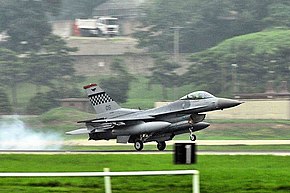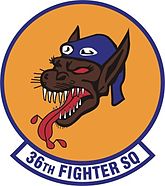36th Fighter-Bomber Squadron
36th Fighter Squadron
 |
|
|---|---|

|
|
| Active | 1917–1919; 1930–present |
| Country |
|
| Branch |
|
| Type | Fighter |
| Part of |
Pacific Air Forces 7th Air Force 51st Fighter Wing 51st Operations Group |
| Garrison/HQ | Osan Air Base, Korea |
| Nickname(s) | The Fabulous Flying Fiends |
| Motto(s) | Check Six! Harrumph! |
| Mascot(s) | Tojo |
| Anniversaries | The Fiend Centennial (28 Sept - 1 Oct 2017 Osan AB, ROK) |
| Engagements |
World War I World War II Korean War Vietnam |
| Decorations |
Distinguished Unit Citation Presidential Unit Citation Air Force Outstanding Unit Award Philippine Presidential Unit Citation Republic of Korea Presidential Unit Citation Republic of Vietnam Gallantry Cross with Palm |
| Commanders | |
| Current commander |
Lt Col Michael McCarthy |
| Notable commanders |
Quentin Roosevelt Ennis Whitehead Major General Scott D. West |
| Insignia | |
| 36th Fighter Squadron emblem (Approved 13 January 1931) |  |
The 36th Fighter Squadron is part of the US Air Force's 51st Operations Group at Osan Air Base, South Korea. It operates the General Dynamics F-16 Fighting Falcon aircraft conducting air superiority missions. The squadron was first activated in 1917 as the 36th Aero Squadron and served in France during World War I, although the war ended before the unit saw combat. It has been continuously active since 1930 as a fighter squadron.
The squadron mission is to conduct air interdiction, close air support and counter-air missions both day and night. It participates in the defense of South Korea and promotes regional stability.
During its 90-year history, the 36th Fighter Squadron has flown 21 different types of aircraft, received 22 unit citations and accumulated 24 service and campaign streamers.
The unit came into existence shortly after the United States entered World War I as the 36th Aero Squadron at Kelly Field, Texas in June 1917. Later that year, First Lieutenant Quentin Roosevelt, the son of President Theodore Roosevelt, briefly commanded the squadron. After a brief training period, the squadron moved overseas on the RMS Baltic. Landing in France in September, 1917, the squadron shortly stopped at the Etampes aerodrome before settling at the 3rd Aviation Instruction Center on Issoudun Aerodrome, where it helped building the new center before being declared operational some time at the end of year. On 21 February, 1918, the 36th Aero Sqn (Repair) arrived at the Cazaux aerodrome, home of the French Aerial Gunnery School, where it helped maintaining the aircraft of the american detachment. On 5 November, it moved to the newly created American Aerial Gunnery School, in St. Jean de Monts, France.
...
Wikipedia
